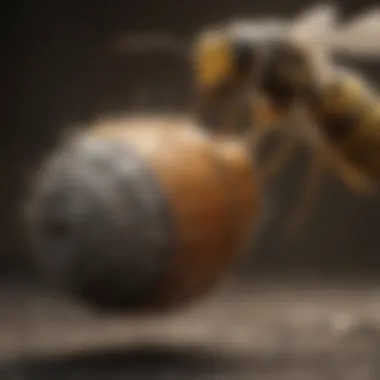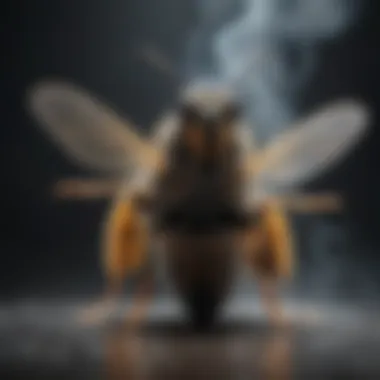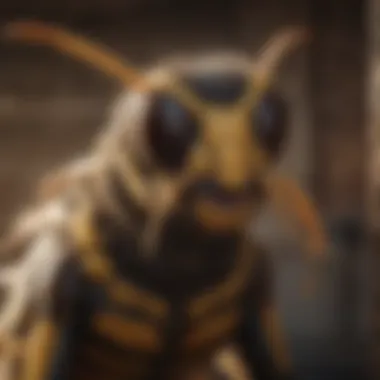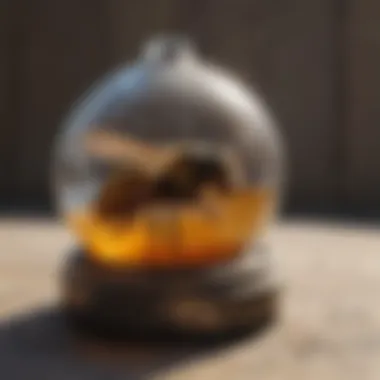Expert Strategies for Safe Wasp Removal: A Comprehensive Guide


Preventive Pest Control Strategies
To effectively eliminate and prevent wasp infestations, it is crucial to start with comprehensive preventive pest control strategies. They form the foundation for a pest-free environment, ensuring the safety of individuals within the household. These strategies encompass various aspects of home maintenance and cleanliness to create an environment that is hostile to wasps. Beginning with safeguarding the house exterior, individuals must focus on sealing cracks and crevices that serve as entry points for pests. By diligently clearing debris and implementing measures to prevent pests from entering the premises, homeowners can significantly reduce the risk of a wasp infestation. Yard maintenance plays a vital role in pest prevention, requiring essential routines such as regular mowing, trimming, and removing standing water sources that attract insects. Indoor cleanliness is equally important, with expert cleaning tips recommending thorough and consistent cleaning practices to deter pests. Maintaining a pest-resistant indoor environment involves proper storage of food, prompt removal of crumbs and spills, and addressing any moisture issues that can attract pests. Effective garbage disposal methods are also essential in preventing pest attractions, highlighting the importance of correctly sealing and disposing of waste to minimize the risk of attracting wasps and other pests. Additionally, homeowners can explore innovative ways to safeguard their homes, such as installing mesh screens on windows and doors, using natural repellents, or planting pest-repelling vegetation around the property.
Understanding Wasps
Understanding wasps is crucial in effectively addressing infestations in a safe manner. By comprehending the behavior and characteristics of wasps, individuals can devise appropriate strategies to manage their presence. This section delves into the physical attributes and behavioral patterns of wasps, shedding light on their nature and habits.
Characteristics of Wasps
Physical Attributes
In examining the physical attributes of wasps, one of the critical aspects to note is their sleek, slender bodies and distinctive coloring. These features aid in their swift movements and also serve as a warning sign due to their vibrant hues. Understanding these physical characteristics is vital for identifying wasps and taking necessary precautions to avoid encounters. Although visually appealing in nature, these attributes can pose risks, signaling the potential threat these insects may present.
Behavioral Patterns
Wasp behavioral patterns revolve around their social structure and interactions within their colonies. These insects exhibit a hierarchical system, with queens, workers, and drones serving specific roles in maintaining the nest. Their behavior is marked by territoriality and defense mechanisms when they perceive a threat. Recognizing these patterns assists in predicting their responses to various stimuli, aiding in the formulation of effective pest control strategies. While these behavioral traits are fascinating, they can also pose challenges when dealing with wasp infestations. Engaging with caution is imperative to mitigate any adverse outcomes.
Potential Risks Associated with Wasps
Exploring the potential risks associated with wasps unveils the dangers individuals may face upon encounters. Allergic reactions stand out as a significant risk, as some individuals can exhibit severe responses to wasp stings. These reactions can range from mild irritation to life-threatening conditions, necessitating immediate medical attention. Furthermore, the aggressive nature of wasps enhances the likelihood of encountering hostile behavior, especially when their nests are disturbed. Understanding these risks underscores the importance of approaching wasp control with diligence and care, considering the potential consequences. Managing these risks effectively is paramount in safeguarding oneself and others from harm.
Allergic Reactions
Delving deeper into allergic reactions caused by wasp stings, it becomes evident that for sensitive individuals, the venom injected during stings triggers an immune response that can lead to various symptoms. From localized swelling to systemic reactions like anaphylaxis, the spectrum of allergic responses underscores the need for caution when dealing with wasps. Recognizing the signs of an allergic reaction is essential for prompt intervention and mitigating severe consequences. While uncommon, these reactions highlight the criticality of taking appropriate measures to minimize exposure and risks associated with wasp encounters.


Aggressive Behavior
The aggressive behavior displayed by wasps serves as a defense mechanism against perceived threats. When faced with disturbances near their nests, these insects can exhibit territorial aggression, stinging repeatedly in defense. This behavior poses a substantial risk, especially in cases where individuals unintentionally provoke or threaten the colony. Understanding the triggers of aggression in wasps aids in avoiding such confrontations and minimizes the chances of sustaining painful stings. While aggression is innate to their survival strategy, minimizing triggers and ensuring safe practices are crucial in mitigating confrontations and potential harm.
Preventive Measures
In the realm of wasp control, preventive measures play a critical role in mitigating infestations. By taking proactive steps to secure entry points and remove attractants, individuals can significantly reduce the likelihood of encountering these buzzing pests. These strategies not only serve to eliminate existing wasps but also act as a barrier against future invasions, creating a sustainable solution to the problem at hand.
Securing Entry Points
As a pivotal aspect of preventive measures, securing entry points involves identifying and fortifying areas where wasps can gain access to a dwelling. Among the various methods employed, sealing cracks stands out for its effectiveness in closing off potential entryways for these insects. Sealing cracks not only prevents wasps from infiltrating indoor spaces but also contributes to overall structural integrity. However, it's essential to ensure thoroughness in the sealing process to minimize the risk of overlooked entry points that could compromise the efficacy of the approach.
Sealing Cracks
Sealing cracks serves as a fundamental yet invaluable practice in warding off wasps from homes and structures. The key characteristic of this method lies in its ability to provide a physical barrier that deters wasps from entering enclosed spaces. Its popular choice stems from the fact that it offers a long-lasting solution that addresses the root cause of infestations, as opposed to temporary interventions. The unique feature of sealing cracks lies in its ability to not only repel wasps but also enhance insulation and energy efficiency within the property. Although requiring time and effort, the advantages of sealing cracks far outweigh any potential disadvantages, making it a preferred strategy in the war against wasp invasions.
Patch Holes
Similarly, patching holes complements sealing cracks in fortifying entry points against wasps. This method targets specific vulnerabilities that may serve as entry points for these insects. By addressing these openings, individuals reinforce the barriers established by sealing cracks, creating a comprehensive defense system. The effectiveness of patching holes lies in its precision and targeted approach, ensuring that no potential access points remain unaddressed. While patching holes may require careful attention to detail, the advantages it offers in bolstering the integrity of preventive measures make it an indispensable component of any wasp control strategy.
Removing Attractants
Apart from fortifying entry points, removing attractants plays a crucial role in deterring wasps from frequenting residential areas. Covering food and practicing proper waste disposal serve as essential measures to minimize the allure of these insects and discourage their presence. By eliminating food sources and implementing efficient waste management practices, individuals can disrupt the foraging patterns of wasps, reducing the likelihood of infestations and nest-building activities.
Covering Food


Covering food acts as a strategic maneuver to deny wasps access to potential nourishment within living spaces. The key characteristic of this practice lies in its ability to limit the exposure of food items that may attract foraging wasps. By utilizing protective measures such as containers and lids, individuals not only safeguard their food supply but also reduce the risk of attracting unwanted insect visitors. The unique feature of covering food lies in its simplicity yet effectiveness in creating a barrier against pests, offering a practical solution to minimizing interactions with wasps. Despite the minor inconvenience it may pose, the benefits of covering food far outweigh any drawbacks, making it an integral part of a comprehensive wasp control regimen.
Proper Waste Disposal
Likewise, proper waste disposal plays a pivotal role in diminishing the potential appeal of residential environments to foraging wasps. By promptly disposing of waste and maintaining cleanliness in outdoor spaces, individuals disrupt the scavenging behaviors of these insects, dissuading them from establishing nests nearby. The key characteristic of proper waste disposal lies in its ability to remove potential food sources that may attract wasps, effectively cutting off their access to readily available sustenance. The unique feature of this practice lies in its dual benefit of not only preventing wasp infestations but also promoting hygiene and sanitation within living areas. Although requiring consistent effort and diligence, the advantages of proper waste disposal in mitigating wasp-related issues justify its incorporation into any comprehensive pest management plan.
Natural Remedies for Wasp Control
In the pursuit of eradicating wasps safely, the utilization of natural remedies stands out as a crucial element. These remedies not only offer an eco-friendly alternative but also provide effective solutions for dealing with wasp infestations without posing significant risks to individuals. Incorporating natural remedies into your wasp control strategy can enhance the overall safety and well-being of your household.
Essential Oils
Peppermint Oil
Peppermint oil emerges as a standout choice in the realm of natural wasp control. Its distinct property lies in its potent scent, deterring wasps effectively while maintaining a pleasant aroma for humans. This dual functionality makes Peppermint oil a popular and effective option for combating wasps. However, it is important to consider that while Peppermint oil serves as a valuable repellent, its efficacy may vary depending on environmental factors and the size of the infestation. Despite this variability, Peppermint oil remains a promising natural remedy in the ongoing battle against wasps.
Lemongrass Oil
Lemongrass oil offers another beneficial avenue for addressing wasp-related concerns. Known for its strong citrus scent, Lemongrass oil acts as a natural deterrent, dissuading wasps from establishing nests in close proximity to treated areas. Its unique feature lies in its ability to repel wasps while emitting a refreshing fragrance. When considering Lemongrass oil for wasp control, it is essential to acknowledge its strengths and limitations. While Lemongrass oil can be effective in certain contexts, its impact may be influenced by environmental conditions and the specific behavior of the wasp species in question. Nevertheless, Lemongrass oil remains a valuable addition to the array of natural remedies available for combating these stinging insects.
Herbal Repellents
Mint
Mint emerges as a compelling herbal repellent in the realm of wasp control. With its aromatic properties and natural deterrent effects, Mint proves to be a popular choice for individuals seeking a non-toxic approach to managing wasp infestations. The key characteristic of Mint lies in its ability to ward off wasps due to its strong scent, which disrupts the insects' foraging patterns and inhibits their nesting instincts. While Mint serves as a promising herbal repellent, its application may require periodic reapplication to maintain its efficacy, especially in outdoor settings with high wasp activity. Despite this need for routine application, Mint stands as a reliable herbal repellent in the ongoing endeavor to address wasp-related challenges.


Basil
Basil represents another herbal remedy that holds significant potential in the realm of wasp control. Known for its aromatic properties and distinct fragrance, Basil serves as a natural deterrent against wasps, preventing them from establishing nests in treated areas. The key characteristic of Basil lies in its ability to repel wasps without resorting to harsh chemicals, aligning well with the eco-friendly principles of natural pest management. While Basil proves to be an effective herbal repellent, its longevity and efficiency may be influenced by factors such as weather conditions and the specific species of wasps targeted. Despite these considerations, Basil remains a promising option for individuals seeking sustainable and natural solutions to mitigate the presence of wasps in and around their living spaces.
Mechanical Traps
Mechanical traps are an essential component when it comes to efficiently eliminating wasps without posing risks to safety. These traps play a pivotal role in capturing and controlling wasp populations in a non-toxic manner, making them an ideal choice for those seeking natural and environmentally friendly solutions. By utilizing mechanical traps, individuals can effectively reduce the number of wasps in their surroundings without the need for harmful chemicals. These traps are designed to attract and trap wasps using mechanisms that are safe for both humans and the environment. When considering methods to combat wasp infestations, incorporating mechanical traps is a strategic and prudent approach.
Types of Traps
Jar Traps
Jar traps are a specific type of mechanical trap that is highly effective in capturing wasps. The key characteristic of jar traps lies in their simplicity and ease of use. They are typically made from common household items such as jars or bottles, along with bait to attract the wasps. Jar traps function by luring the wasps into the container, where they become trapped and unable to escape. One of the main advantages of jar traps is their cost-effectiveness and accessibility, as they can be easily assembled at home using minimal resources. However, a potential disadvantage of jar traps is that they may need to be monitored regularly to ensure captured wasps are removed promptly to prevent attracting more. Despite this, jar traps remain a popular choice for those looking to eliminate wasps safely and efficiently.
Water Bottle Traps
Water bottle traps are another effective mechanical solution for controlling wasps. These traps make use of empty plastic bottles or containers filled with a liquid bait to entice and trap the wasps. The key characteristic of water bottle traps is their versatility and ease of setup. They can be deployed in various locations both indoors and outdoors, making them a convenient option for addressing wasp infestations. One unique feature of water bottle traps is their ability to capture a significant number of wasps due to the design of the trap, which prevents the insects from escaping once inside. While water bottle traps are generally effective, one potential drawback is that they may need to be replenished regularly with fresh bait to maintain their efficiency. Overall, water bottle traps offer a practical and efficient method for individuals seeking to eliminate wasps safely using a mechanical approach.
Professional Assistance
Seeking professional help for addressing wasp infestations is a critical step in ensuring effective and safe elimination. Professional exterminators possess the expertise, experience, and specialized tools necessary to handle wasp nests efficiently, minimizing risks to individuals and properties. Their thorough knowledge of wasp behavior enables them to tailor specific treatment plans to each unique infestation scenario. By entrusting the task to professionals, homeowners can guarantee a swift and precise resolution to the issue, restoring peace of mind within the household.
When to Seek Help
Large Nests
Large wasp nests pose a significant threat due to the sheer number of wasps they can accommodate, intensifying the potential dangers associated with attempting removal independently. Their vast size indicates a prolonged existence, with established colonies capable of aggressive defense when disturbed. Professional assistance becomes imperative in handling such nests, as experts can accurately assess the situation, determine the most suitable eradication method, and execute it safely. Despite the formidable challenge large nests present, exterminators equipped with advanced protective gear and industry-grade solutions can effectively neutralize these complex infestations, ensuring long-term prevention of recurrent issues and safeguarding the surrounding environment.
Persistent Infestations
Persistent infestations signify recurring incidents of wasp presence, indicating underlying attractants or conducive conditions that sustain their populations. These instances often signify a deeper-rooted infestation or a habitat supporting multiple nest sites within the vicinity. Professional exterminators excel in diagnosing the root cause of persistent infestations, implementing targeted strategies to eliminate all existing nests comprehensively, and deploying preventive measures to deter future reinfestations. Their in-depth understanding of wasp biology and habitats enables them to address the infestation at its source, enhancing the likelihood of long-lasting results and providing homeowners with a lasting solution to their recurrent wasp problems.



